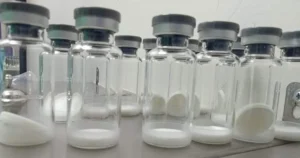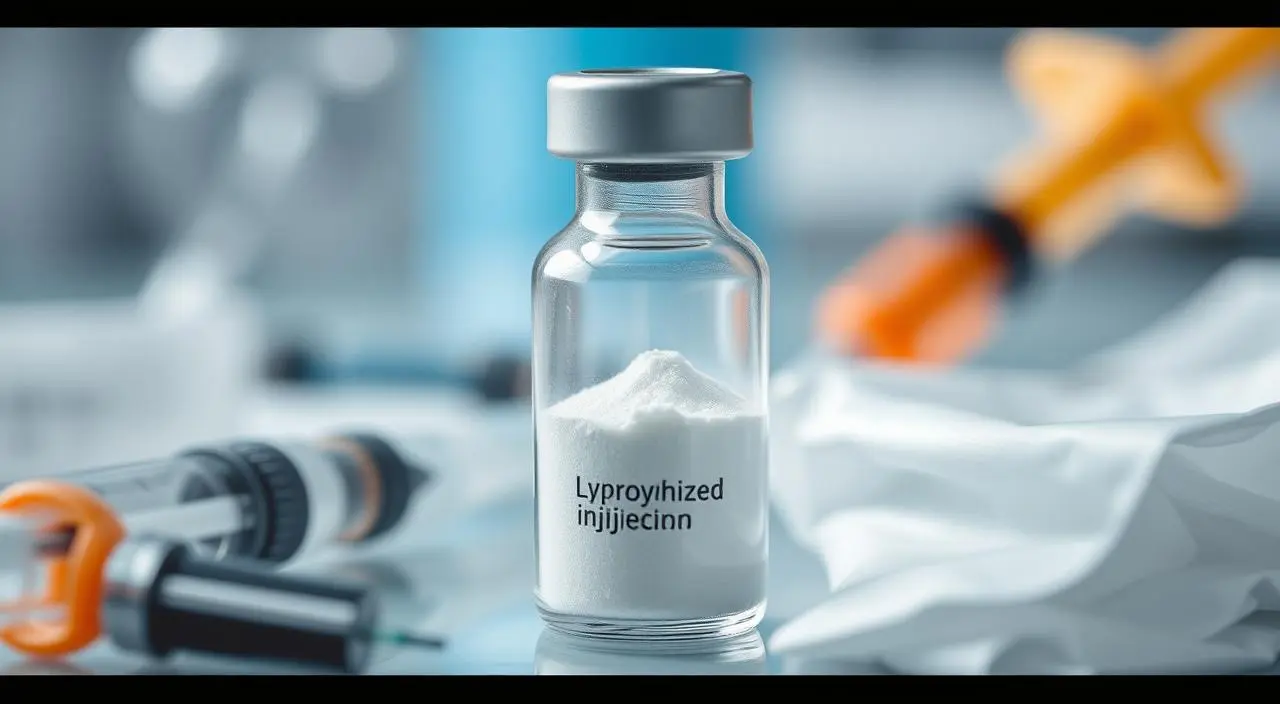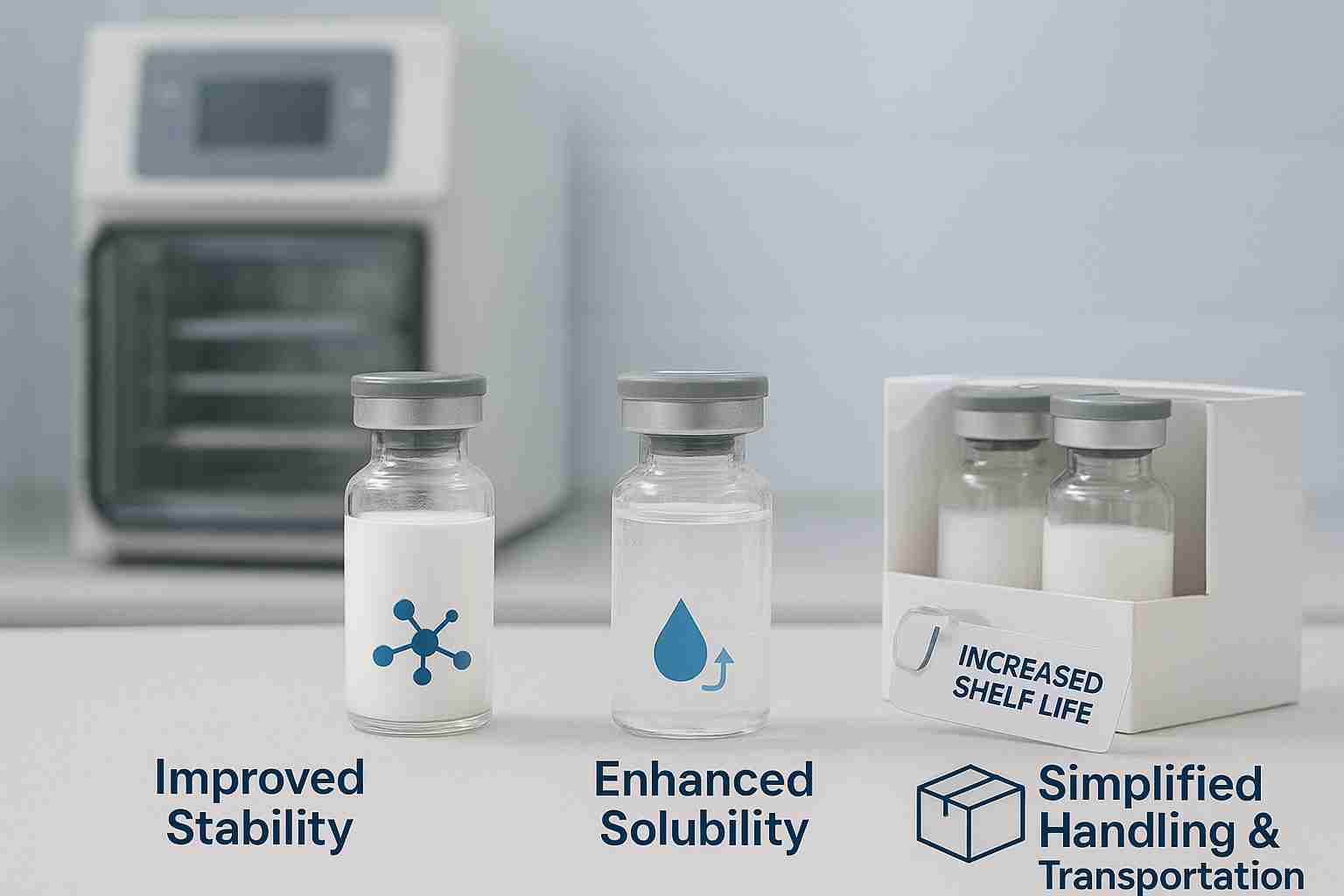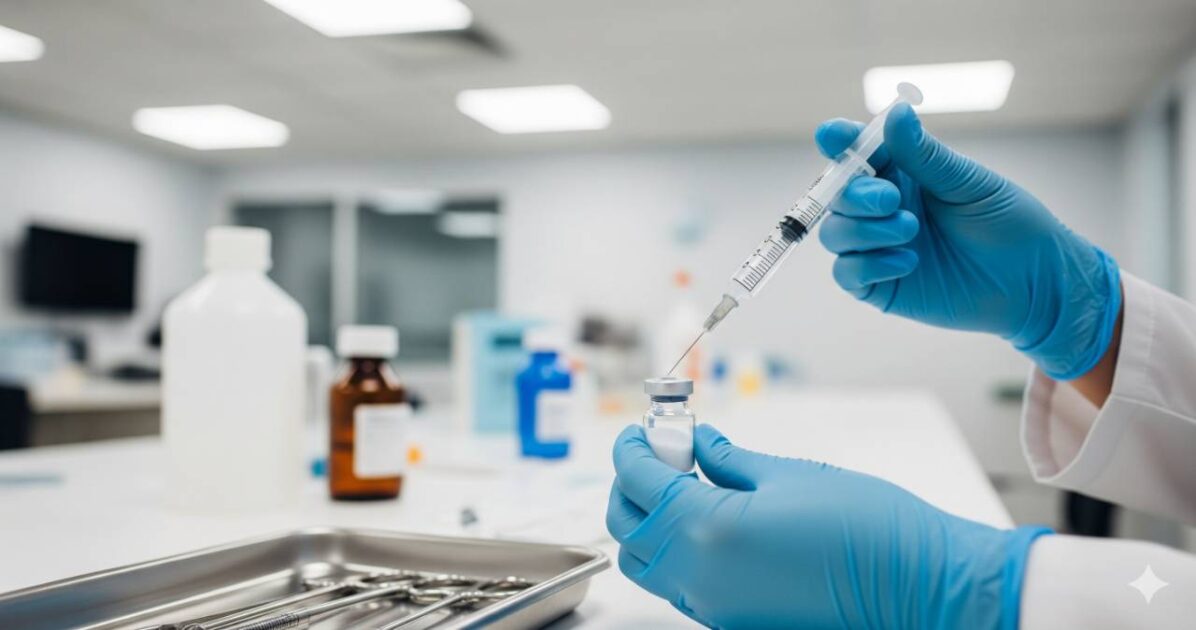The use of lyophilized powder for injection has become a cornerstone in modern medicine, with over 90% of injectable drugs relying on this technology. Lyophilization, also known as freeze-drying, removes water from drug formulations while preserving their potency and structure. This process ensures medicines remain stable, sterile, and effective, making them easier to transport, store, and administer to patients worldwide. For a deeper understanding of the process itself, you can explore the lyophilization process efficiency best practices.
One of the main advantages of lyophilized powder for injection is its ability to enhance drug stability and extend shelf life. Sensitive biologics, antibiotics, vaccines, and chemotherapy agents often degrade quickly in liquid form, but lyophilization protects their integrity. Once reconstituted with the right diluent, these powders transform into safe and effective injectable solutions, providing healthcare professionals with reliable treatment options. To ensure consistent results, manufacturers follow strict GMP freeze-drying guidelines and monitor chamber pressure during primary drying.
In this article, we’ll explore the uses, benefits, and handling requirements of lyophilized powders for injection. From proper aseptic fill-finish and lyophilization techniques to addressing issues like impact of sealing defects on drug sterility, this guide highlights why lyophilized powders are vital in pharmaceuticals. For anyone interested in quality assurance, resources like lyophilized product quality standards and defect classification in lyophilized products provide essential insights.

Key Takeaways
- Lyophilized powder for injection is a common pharmaceutical formulation that offers enhanced stability and sterility for a wide range of injectable drugs.
- The lyophilization process, or freeze-drying, removes water from the drug product, extending its shelf life and improving its deliverability.
- Proper reconstitution techniques are essential to ensure the safety and efficacy of lyophilized powder for injection products.
- Strict aseptic handling and sterile reconstitution protocols are crucial to maintaining the integrity of these injectable medications.
- Comprehensive stability testing and regulatory compliance are essential to ensuring the quality and safety of lyophilized powder for injection formulations.
Understanding Lyophilized Powder for Injection Uses
Lyophilized powder, also known as freeze-dried powder, is key in the world of medicine. It’s a new way to make drugs that has many advantages. This makes it popular among pharmaceutical companies and healthcare providers.
Parenteral Drug Delivery
Parenteral Drug Delivery Overview means giving medicines through ways other than the stomach, like shots. Lyophilized powder is great for this because it keeps the medicine stable and easy to mix.
Benefits of Lyophilization
- Improved injectable drug stability: The process of lyophilization keeps the medicine’s structure intact. This means it stays potent and works well.
- Enhanced drug solubility: lyophilized powders dissolve easily in the right liquid. This makes mixing and giving the medicine simpler.
- Increased shelf life: These powders last longer than liquid medicines. This makes them easier to store and send out.
- Simplified handling and transportation: Because they’re dry and compact, lyophilized powders are easy to handle and ship. This lowers the chance of contamination or damage.
Using the lyophilization process lets pharmaceutical companies make injectable drugs that are more stable and easy to use. This improves patient care and results.
Reconstitution Techniques for Lyophilized Powders
Properly reconstituting lyophilized powder is key for a safe and effective injectable product. This process means adding the right diluent to the powder. This makes a solution of the correct concentration.
Choosing the right diluent is important. Reconstitution diluents must work well with the active ingredient and other parts of the powder. Common diluents include sterile water for injection, saline solutions, or other suitable solvents.
The steps to reconstitute are as follows:
- Check the lyophilized powder for any damage or defects.
- Swirl or roll the vial to mix the powder without causing air bubbles.
- Add the right amount of diluent, as the instructions say, to the vial.
- Swirl or roll the vial again to dissolve the powder fully, avoiding foam or bubbles.
- Look at the solution for any particles or color changes. If you see any, throw it away.
It’s crucial to keep the reconstitution process sterile to avoid contamination. This means working in a clean area and using aseptic techniques.
By using these best practices for reconstitution techniques, healthcare workers can make lyophilized powder safe and ready for use.
Sterile Reconstitution and Aseptic Handling
Keeping sterile reconstitution and aseptic handling right is key when working with lyophilized powder for injection. Doing it right is vital for the product’s safety and effectiveness. It also helps avoid contamination, which could harm the injectable drug’s stability.
Importance of Sterility: Sterility is crucial when mixing lyophilized powders. If you don’t follow sterile steps, you could introduce harmful germs. This risks patients’ health. It’s important to stick to aseptic methods to keep the medicine safe and protect people’s health.
Aseptic Techniques: Handling lyophilized powders safely means following specific steps. This includes washing hands properly, using only sterile tools, and working in a clean area. Knowing aseptic techniques well is key to safely mixing these important medicines.
- Properly clean and disinfect the work surface
- Wear appropriate personal protective equipment (PPE)
- Carefully reconstitute the powder using sterile diluent
- Inspect the reconstituted solution for any visible particulates or discoloration
- Properly label and store the reconstituted medication
Following strict sterile reconstitution and aseptic handling rules helps healthcare workers keep lyophilized powder for injection safe. This ensures patients get the best care possible.
Lyophilized powder for injection uses
Lyophilized powder for injection is now widely used in the pharmaceutical industry. It offers many benefits and applications. These powders help deliver drugs, biologics, and other products through parenteral drug delivery.
The freeze-drying pharmaceuticals process has many advantages. It removes water, making the active ingredients more stable and long-lasting. This is great for drugs that don’t keep well in liquid form.
| Application | Example Drugs |
|---|---|
| Biologics | Monoclonal antibodies, vaccines, enzymes |
| Small Molecule Drugs | Antibiotics, antineoplastics, cardiovascular agents |
| Combination Therapies | Antiretroviral drugs, chemotherapy regimens |
Lyophilized powder for injection uses are not just about the drug itself. These powders can be mixed with different liquids. This lets doctors and patients choose the best way to give the medicine.
Lyophilization has changed how we give important medicines. It keeps them stable and effective. Plus, it gives us more ways to give them.
Stability Testing and Protocols
Ensuring the long-term stability and quality of lyophilized powder for injection is key in pharmaceutical development. Comprehensive stability studies are done to check the product’s physical, chemical, and microbiological properties over time. These studies help understand the drug’s strength, purity, and safety. They guide manufacturers in making better formulations and storage conditions.
Stability Studies
Lyophilized powder for injection goes through tough stability testing. This includes accelerated, real-time, and stress testing. Accelerated studies speed up the product’s aging process under high temperature and humidity to see how long it will last. Real-time studies watch how the product does under normal storage conditions, like what happens in real life. Stress testing checks how strong the formula is and if it can handle different environmental factors, making sure it’s tough.
Regulatory Requirements
The FDA (Food and Drug Administration) and other groups have set rules for testing the stability of lyophilized powder for injection. Companies must follow these rules to make sure their products are safe, work well, and are of high quality. This means doing thorough stability studies, following strict quality control, and sending detailed data to authorities for review and approval. By doing this, pharmaceutical companies can safely and reliably offer lyophilized powder for injection to the market.
How to Prepare a Lyophilized Powder for Injection?
To prepare a lyophilized powder for injection, healthcare professionals follow a sterile reconstitution process that ensures the medicine is safe, stable, and effective for patient use. The powder, produced through the freeze-drying (lyophilization) process, must be handled carefully to maintain sterility and potency. read more
Steps for Preparation
-
Inspect the Vial – Check the lyophilized powder for cracks, collapse, or discoloration. If defects are present, the vial should not be used.
-
Choose the Correct Diluent – Use the recommended diluent (e.g., sterile water for injection or saline solution) as per the drug label.
-
Add Diluent Sterilely – Using aseptic technique, withdraw the required amount of diluent with a sterile syringe and inject it into the vial.
-
Dissolve the Powder – Gently swirl or roll the vial to dissolve the powder. Avoid shaking vigorously to prevent foam or air bubbles.
-
Check the Solution – Inspect the reconstituted solution for particulates or color changes. If abnormalities are seen, discard it.
-
Administer Immediately – Once reconstituted, most lyophilized injections must be used promptly or stored under specific conditions as directed.
Why Preparation Matters
Proper reconstitution is essential to preserve drug safety, efficacy, and sterility. Errors in handling can compromise treatment outcomes and patient safety.
💡 For a deeper understanding of how freeze-drying enhances drug quality and stability, you can explore our guide on Lyophilization Process Efficiency Best Practices.
Conclusion
The use of lyophilized powder for injection has revolutionized pharmaceutical formulations by offering unmatched stability, sterility, and extended shelf life for sensitive drugs. Through the freeze-drying process, medicines maintain their potency and can be safely stored, transported, and reconstituted without losing effectiveness. By following strict aseptic handling, sterile reconstitution practices, and regulatory stability testing, manufacturers and healthcare providers ensure these products meet the highest standards of safety and quality. Ultimately, lyophilized powders play a critical role in modern parenteral drug delivery, supporting reliable treatments and improved patient outcomes worldwide
FAQ of lyophilized powder for injection
What are the common uses of lyophilized powder for injection?
Lyophilized powder for injection is a key pharmaceutical product. It improves drug stability and makes storage easier. It’s used to deliver many drugs and biologics through injections.
How does the lyophilization process benefit injectable drug stability?
Lyophilization, or freeze-drying, removes water from the drug. This leaves a stable, dry powder. This process makes the drug more stable, extending its shelf life and improving storage conditions.
What are the key steps in the reconstitution of lyophilized powder for injection?
Reconstituting lyophilized powder involves adding the right amount of diluent to the powder. This ensures the correct concentration. It must be done in a clean environment using aseptic techniques to keep the product safe and effective.
Why is sterile reconstitution important for lyophilized powder for injection?
Keeping the reconstitution process sterile is key to avoiding contamination. This ensures the injectable product is safe and works as it should. Using clean equipment and work areas is vital for this.
What are the regulatory requirements for the stability testing of lyophilized powder for injection?
Lyophilized powder for injection must meet strict rules for stability testing. This includes detailed studies to check its long-term quality and safety under different storage conditions.
What are the basic lyophilized product inspection requirements?
Lyophilized products must be checked for cake integrity, absence of foreign particles, correct moisture content, and proper container sealing to meet regulatory quality standards.
What regulations govern lyophilized product inspection?
Both FDA and EMA require strict compliance with Good Manufacturing Practices (GMPs), validated inspection procedures, and documentation of results to ensure patient safety.
What are the key lyophilized powder inspection guidelines?
Guidelines include verifying uniform cake structure, monitoring for cracks or collapse, checking stopper integrity, and ensuring the product reconstitutes correctly.
How is visual inspection of lyophilized products performed?
Visual inspection is done manually or with automated systems under controlled lighting to detect cosmetic defects, particulate matter, or container closure issues.
What is the standard lyophilized powder inspection procedure?
The procedure involves visual checks, container closure integrity testing, moisture analysis, and batch record review to confirm quality before product release.
Why is lyophilized powder visual inspection important?
Visual inspection ensures product stability, prevents contamination, protects patients from unsafe drugs, and keeps manufacturers in compliance with regulatory authorities.


